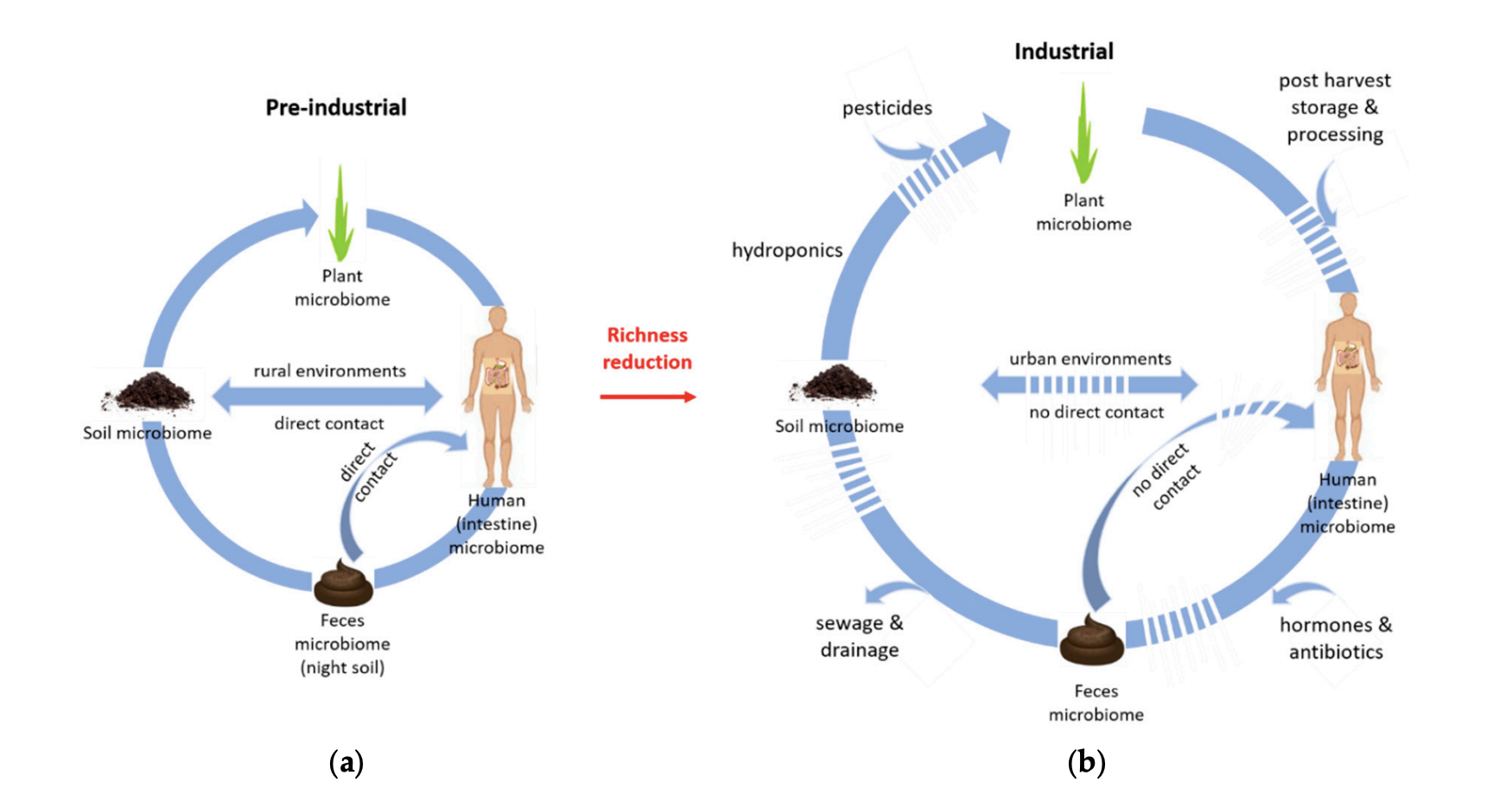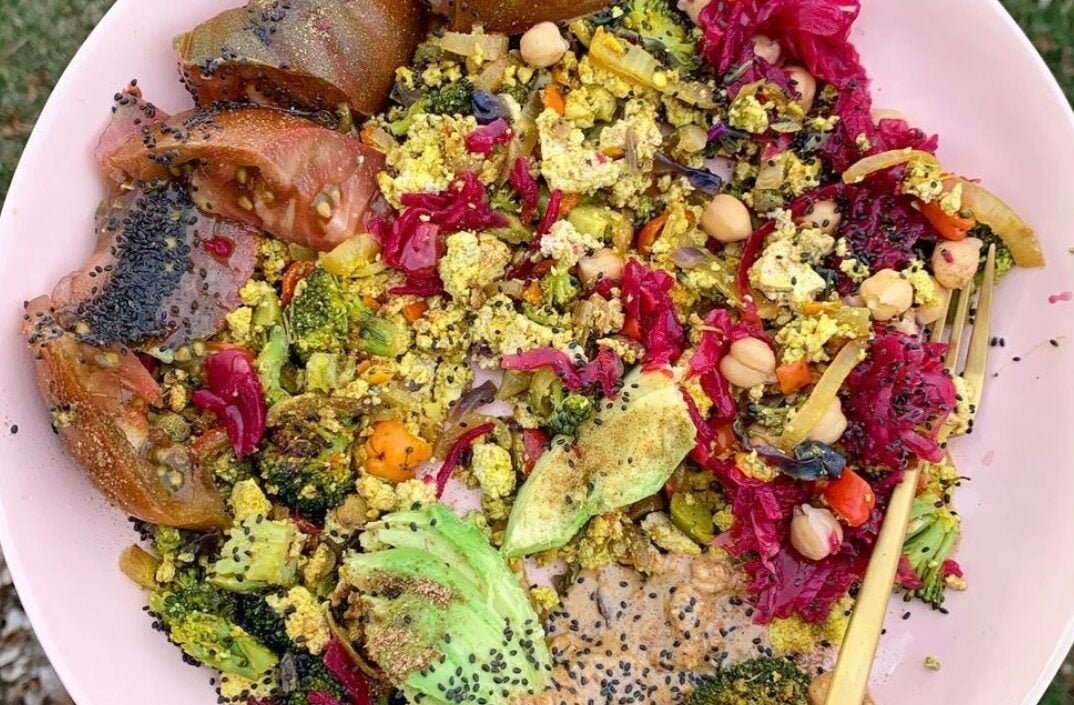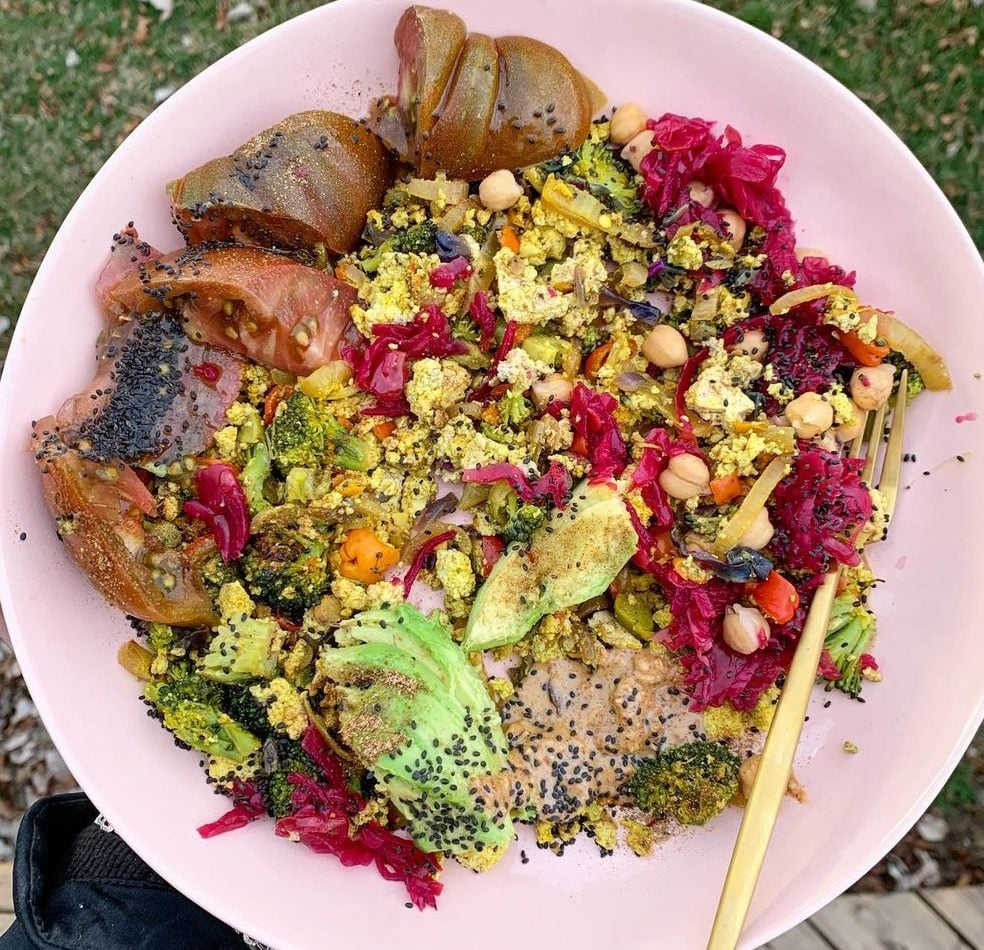There’s a critical point to recognize if we are going to achieve optimal health and thrive:
You can’t have optimal health of the body without optimal health of the soil that our food is grown in. And vice versa.
So if you care about improving metabolic health, it’s time to care about soil. Unfortunately, our soil health is under siege with modern industrial farming practices, and we are all paying the price in the form of nutrient-depleted food that contributes to dysfunctional physiology that results in excess weight and chronic disease. In this newsletter, I’ll share four reasons why soil health and metabolic health are inextricably linked:
- Our body’s microbiome is influenced by the soil’s microbiome
- Poor soil leads to micronutrient-depleted foods
- Animals raised on good soil have more omega-3s and phytochemicals
- Pesticides are toxic obesogens making us fat and metabolically ill
Background
Let’s start with the basics: The human body is a collection of atoms, and those atoms are in constant flux with the outside world. In our lifetimes, we will eat around 70 tons of food! Seventy tons of atoms that we incorporate into our body to replace, rebuild, and renew ourselves. We take products from the earth, transmute them into ourselves, and then discard waste, which the earth assimilates and renews into new natural products in a constant cycle. This trading of resources is happening every second. When we recklessly pollute or unsustainably utilize the earth and therefore disrespect the physical substrate that will become our bodies, we only hurt ourselves. Our chronic disease epidemic is a result.
This transformation process of earth into the body is facilitated by sunlight, bacteria, and mycelium (fungal) networks [more below]. In a previous newsletter, I wrote about the importance of sunlight for metabolism. And bacteria, whether in our gut microbiome or the soil microbiome, are also crucial for metabolic health.
Unfortunately, our soil is becoming unbelievably depleted of life. Our soil has gone from being a living thing to being just dirt, which is lifeless or dead. What makes soil alive is the bacteria, bugs, worms, and fungi that compose its microbiome and cycle resources within it.
We need to flip the switch from the soil-depleting agricultural practices of monocropping, aggressive tilling, and using pesticides, synthetic fertilizers, and herbicides to the soil-preserving methods of regenerative farming and sustainable practices that respect the natural and regenerative cycles of the earth. You may not be a farmer yourself, but you can still do things to ensure you’re getting foods grown via soil-sustaining practices, and you can exercise your vote when it comes to agricultural initiatives.
4 Ways Soil Health Is Related to Metabolic Health
1. Our body’s microbiome is influenced by the soil’s microbiome
If you scooped a clump of functional soil in your hand, it would contain a microbiome of 10 million to 100 million organisms, including hundreds to thousands of invertebrate and nematode species, hundreds of fungi species, and thousands of bacterial species. (Soil really is alive!)
Fungi play quite a special role. Mycelium networks are tiny underground threads of fungal organisms. These threads tangle around and infiltrate tree and other plant roots to create a more extensive mycorrhizal network—the “wood-wide web!” The network serves as a communication and transfer system so plants can trade nutrients and water.
Unfortunately, conventional farming practices—especially dumping chemicals onto soil and crops—dramatically degrade that network and overall microbiome. A research review on pesticides and their effects on soil invertebrates alone found that pesticides negatively impacted the organisms by as much as 70 percent. In a Yale Environment 360 interview with U.S. Department of Agriculture researcher Rick Haney, he says pesticides are “like chemotherapy for cancer: It’s not targeted, it just kills everything.” Synthetic fertilizers may provide a high crop yield in the short term, but they deplete organic matter and essential nutrients and kill bacteria. Herbicides (think glyphosate, aka “Roundup”) have been shown to harm bacteria and fungus, as well, impairing that delicate but crucial mycorrhizal network by as much as 40 percent.
We now know that a diverse human microbiome composition is a key determinant of physical and mental health, including immunity, healthy weight, and chronic disease predisposition. Unfortunately, we are seeing a “megatrend of biodiversity loss” with reduced diversity across soil, crops, and human microbiomes. These reductions are related to several aspects of urbanization and modernization, including an ultra-focus on hygiene, minimized childhood interactions with soil, excessive antibiotic use, low-fiber ultra-processed diets, and “high-efficiency, high-yield” based farming. Together these factors have led urban dwellers in particular to have reduced bacterial diversity.

The microbiota in our environment influence the human intestine microbiome, via direct contact with soil and feces as well as via food (quality). Our ancestors lived in close contact with the environment (a, a cycle for pre-industrial microbiota). In contrast, human activities such as urbanization, industrialization of agriculture, and the modern lifestyle, including the use of pesticides and antibiotics as well as hormones (medication), together the loss of direct contact with soil and feces has depleted the richness of and overlapping with microbiota (b, a cycle for industrial microbiota). This depletion of microbial richness in all compartments can substantially affect human health. Source
Regenerative farming principles focus on soil health. They utilize diverse crop rotation, avoid pesticides, minimize tilling, and employ composting and other practices. Regenerative farming “increases biodiversity, enriches soils, improves watersheds, and enhances ecosystems.” Conventional farming, on the other hand, often employs the method of monocropping, planting the same crop over and over. Research shows that long-term monocropping leads to soil sickness, a reduction in diverse bacteria. All these practices that deplete the vitality of soil—converting it to lifeless dirt—affect our metabolic health. They do this by negatively impacting our food. They deplete the micronutrient composition, increase the content of obesogenic pesticide toxins, and decrease the microbial diversity of what we eat.
2. Poor soil leads to micronutrient-depleted foods
In a previous newsletter, I wrote about the magic of micronutrients—the vitamins, trace minerals, and antioxidants—we get from foods. They are crucial links in chain reactions that regulate every part of your body’s metabolism.
Soil plays a significant role in ensuring we get abundant amounts of micronutrients. One study pitted regenerative farms against conventional farms in a head-to-head soil, crop, and even animal product comparison.
One metric the researchers looked at was soil organic matter, which is the amount of the soil made up of plant or animal material in various stages of decay. This is a common soil health metric.
On average, the regenerative farms had 6.3 percent organic matter in their soil and earned a health score of 20. By comparison, on average, conventional farms had 3.5 percent organic matter and a health score of 8. Crops harvested from the regenerative farm soil also had higher percentages of micronutrients. The percentages listed here show how much more (on average) of a specific micronutrient was present in the crops harvested from regenerative soil compared to crops harvested from conventional farm soil.
- Vitamin K: 34%
- Vitamin E: 15%
- Vitamin B1: 14%
- Vitamin B2: 17%
- Carotenoids: 15%
- Phenolics: 20%
- Phytosterols: 22%
- Calcium: 11%
- Phosphorus: 16%
- Copper: 27%
Additionally, the same study showed that produce from regenerative no-till vegetable farms, when compared to vegetables bought at supermarkets, had higher levels of phytochemicals. Specifically, the researchers looked at levels of phenolics, also called polyphenols, known for their antioxidant properties, which help our bodies battle oxidative stress. From regenerative farms, cabbage had 2.5 times more, spinach had 4 times more, and carrots had about two-thirds more phenolics compared to the phenolic values of the same vegetables from New York supermarkets.
3. Regeneratively raised animals have more omega-3s
Animals are raised differently on regenerative farms. Regenerative farms tend to not just raise crops; they also have roaming animals, given that there is a natural beneficial cycle that takes place when plants and animals interact. Regeneratively raised animals are generally pastured, in a rotational manner, on the land that also provides their feed. This means they graze in a specific area while other sections of the pasture land “rest,” allowing grazing plants and their root systems to recover.
Livestock have an important role in creating a closed-nutrient loop via depositing manure and their stomping or trampling, which integrates the organic matter (of manure and plants) into the soil. This reduces the need for external sources of fertilizer and even irrigation in some cases, by improving water retention. Intentional pasture raising on rotation like this also has the added benefit of boosting the health of the mycorrhizal network rather than depleting it. The depositing and trampling of organic matter stimulate plant-soil interaction and allows the land to later flourish during its rest period while the livestock work another section.
Pasture-raised livestock live naturally on the land, getting more exercise and sunlight, making them metabolically healthier overall—as outlined below. In turn, if you eat animal products, regeneratively raised meat and dairy are healthier for you.
We have a Levels blog post about why omega-3 fatty acids are crucial to strong metabolic health. The study on soil from regenerative farms also investigated the unsaturated fatty acid profile of livestock. The researchers compared the nutritional content of beef and pork sourced from a regenerative farm to that of conventionally raised meat.
The beef from the regenerative farm had 3 times more omega-3 fats—and specifically over 6 times more alpha-linolenic acid (ALA) than beef raised conventionally. ALA is considered an “essential” omega-3 fatty acid because the body can’t make it independently and must obtain it through foods. The regenerative beef also had 50 to 75 percent more eicosapentaenoic acid (EPA) and docosahexaenoic acid (DHA).
The pork from the regenerative farm had 9 times more omega-3s, with 11 times more ALA than the conventional sample, 2 times more EPA, and 4 times more DHA.
Both regenerative meats also had more favorable omega-3 to omega-6 ratios when compared to the conventionally raised livestock.
Beef
- Regenerative: 1.3:1
- Conventional: 6.2:1
Pork
- Regenerative: 8:1
- Conventional: 24.5:1
At a ratio of 16:1, the typical Western diet contains too many omega-6s and a dearth of omega-3s. Omega-3s help limit the pro-inflammatory impact of omega-6s. Research has established that humans evolved on a diet in which the ratio was close to 1:1. The proportion of omega-6s in Western diets increased during the 20th century as people began to consume more soybean oil, which is high in linoleic acid (an omega-6). A lower ratio is generally considered metabolically healthier.
But that’s not all. Meat and milk products from pasture-raised livestock that graze on a variety of plant species also have the added benefit of containing phytochemicals—with some levels on par with plant-based foods. That’s typically not the case with products from livestock fed grain in a feedlot. For example, cattle raised on mountain pastures produce milk with 6 times more flavonoid and caffeoylquinic acid (CQA) than cattle raised on just one type of grass. These phytochemicals are undetected in milk from cattle raised and fed in confinement. Flavonoids and CQAs are potent antioxidants.
Research shows that the more diverse grazing for cattle the higher the concentration of phenols, which are another type of antioxidants. Plus, pasture-grazed goats also produce milk higher in equol and formononetin, which are both isoflavones, and also enterolactone, which is a lignan, than milk produced in feedlots. Diets higher in equol or enterolactone are associated with lower levels of low-density lipoprotein (LDL) “bad” cholesterol and C-reactive protein, a marker of inflammation.
4. Pesticides are toxic obesogens making us fat and metabolically ill
Many of the chemicals sprayed on conventionally grown food are known to be obesogens, meaning that they are chemicals that are causatively linked to promoting fat storage. This means that even if you are eating nutrient-dense, healthful foods, you may be getting a side-dish of fat-promoting, metabolically disruptive invisible chemicals all over it. The recent landmark review on obesogens published earlier this year highlights that pesticides can accumulate in fatty tissues. That total body burden of pesticides (in this case, DDT/DDE) is positively associated with BMI, waist circumferences, and visceral and subcutaneous fat. Of note, there is some inconsistency amongst the data on this topic, but when the study authors put animal, in vitro, and human data together, they found the evidence to be strong.
Many of these agricultural chemicals are “persistent organic pollutants,” or “POPs,” meaning that they stick around in our environment and may have multigenerational effects, so even if they are banned, their negative effects can impact generations to come. The US notably lags behind many other countries in our regulation of agricultural chemicals that are known to be “extremely” or “highly” hazardous to human health, and of the pesticides used in US agriculture in recent years, “322 million pounds were of pesticides banned in the EU.”
Interestingly, cereal and oat snack bars are a massively contaminated food category when it comes to glyphosate (Roundup). In a study by the Environmental Working Group, all 28 cereals they tested had glyphosate detected, with the highest level found in Quaker Oatmeal Squares, at nearly 18 times higher than the EWG’s children’s health benchmark of 160 parts per billion (Quaker squares were at 2,837 ppb!).
Get to know local farmers (the farmers market is a great place to do this) and learn exactly what they use on their crops.
Regulators are not looking out for your metabolic health when it comes to pesticide use; it’s up to you.
12 Ways to Improve Your Relationship with Soil
You may not raise food or animals, but you can take action to change some of your food sources to boost your metabolic health and to support farmers who are engaging in regenerative practices that give back to the soil rather than deplete it.
- Learn about sustainable agriculture. Check out Kiss the Ground and The Biggest Little Farm, two incredible documentaries on regenerative farming.
- Find a local farmers market. Make a point to chat with a few of the farmers about how they grow their crops. Some farms may not be labeled organic (due to how cumbersome and costly the certification is), but the farmer can tell you that they use no chemical sprays. These are some of my favorite conversations of the week!
- Grow something! Try growing some type of food in your home to get in touch with the food production process. Start with something simple like a potted basil plant from Trader Joe’s or Whole Foods! Interacting with indoor plants has a measurable positive impact on our stress levels while also generating appreciation and awe for how food develops and grows.
- Get your (and your kids’) hands in the dirt! Volunteer at a community garden or local farm, or just do some yard work.
- Start composting. Check out Cornell Waste Management Institute’s tips and resources on small-scale or backyard composting. You can also search for a compost pickup service in your area.
- Support CSAs. Join a community-supported agriculture (CSA) program through a regenerative or organic farm.
- Support farm-to-table and organic menu restaurants. Some chains like Sweetgreen and Dig are even supporting regenerative farms.
- Shop regenerative. Try to buy products and brands that source from regenerative farms. Look for companies with the Land to Market seal.
- Go organic. When regenerative produce is not available, try to get some organic options. To keep costs down, look for what’s organic that is on sale, in cans, or in the frozen section (often cheaper!).
- Get involved locally. Advocate for pesticide-free parks in your town!
- Avoid toxic pesticides in your garden (like Roundup spray, which is very common), and ask anyone who helps maintain your yard or neighborhood public spaces to avoid them. There are several non-toxic weed management recipes online utilizing vinegar and salt.
- Know the politics. Read up on the 2023 Farm Bill and sign up to follow the #regenerateamerica campaign, which will help keep you informed on how to use your voice and vote to support sustainability.
Final Thoughts
We are in a direct, continuous relationship with the earth. It’s where we came from, it’s what continually builds our body during our lifetime, and it’s where we will go back to. When we poison or abuse our source and our final resting place, we hurt ourselves. When we engage in a symbiotic relationship with the earth, however, it will generously sustain us. Small steps can make a big difference. Our metabolic health (which dictates our mental and physical health) depends on honoring this relationship.








